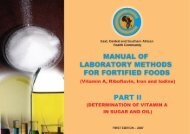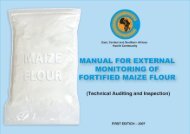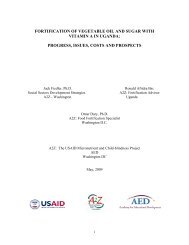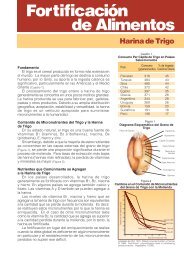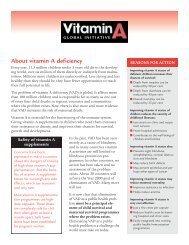manual of methods for determining micronutrients in fortified foods
manual of methods for determining micronutrients in fortified foods
manual of methods for determining micronutrients in fortified foods
You also want an ePaper? Increase the reach of your titles
YUMPU automatically turns print PDFs into web optimized ePapers that Google loves.
− 1,10-phenanthrol<strong>in</strong>e-monohydrate, p.a., mol wt.= 198.23.<br />
− Hydroxylam<strong>in</strong>e hydrochloride (NH 2<br />
OH.HCl), p.a., mol wt = 69.49.<br />
− Glacial acetic acid (CH 3<br />
COOH), p.a., mol wt. 60.05.<br />
− Standards Solution <strong>for</strong> iron Ammoniacal Ferrous Sulfate, Fe (NH 4<br />
) 2<br />
( SO 4<br />
) 2<br />
.6H 2<br />
O, mol wt 392.14<br />
VI. Solutions<br />
a. 1,10-phenanthrol<strong>in</strong>e.H 2<br />
O<br />
Dissolve 0.1 g 1,10-phenanthrol<strong>in</strong>e.H 2<br />
O <strong>in</strong> ca 80 mL H 2<br />
O at 80° C, let it cool down, and dilute to 100<br />
mL. Store <strong>in</strong> a dark bottle under refrigeration. The solution is stable <strong>for</strong> several weeks. Discard if the<br />
solution turns lightly p<strong>in</strong>k, <strong>in</strong>dicat<strong>in</strong>g that it has been contam<strong>in</strong>ated with iron.<br />
b. Acetate Buffer-2 M<br />
In a 500 mL beaker add 68 g sodium acetate trihydrate, and dissolve <strong>in</strong> approximately 100 mL <strong>of</strong><br />
deionized water. Add 60 mL <strong>of</strong> glacial acetic acid and dilute to 500 mL. Transfer the solution <strong>in</strong>to a glass<br />
flask with hermetical cover. The solution is stable <strong>for</strong> <strong>in</strong>def<strong>in</strong>ite time.<br />
c. Hydroxylam<strong>in</strong>e Hydrochloride –10 %<br />
Add 10 g <strong>of</strong> hydroxylam<strong>in</strong>e hydrochloride <strong>in</strong>to a beaker, and dissolve with 100 mL <strong>of</strong> deionized water<br />
with the aid <strong>of</strong> a glass rod. Transfer the solution <strong>in</strong>to a glass flask with hermetical cover. The solution<br />
is stable <strong>for</strong> <strong>in</strong>def<strong>in</strong>ite time.<br />
VII. Standard solutions<br />
a. Primary Standard Solution <strong>of</strong> Iron – 1000 mg/L<br />
Dissolve 3.512 g <strong>of</strong> Fe(NH 4<br />
) 2<br />
(SO 4<br />
) 2<br />
.6H 2<br />
O <strong>in</strong> distilled water, and add a few drops <strong>of</strong> concentrated HCl.<br />
Dilute to 500 mL <strong>in</strong> a volumetric flask. Transfer the solution to a plastic bottle. This solution is stable<br />
<strong>for</strong> <strong>in</strong>def<strong>in</strong>ite time, unless a light p<strong>in</strong>k color is observed <strong>in</strong>dicat<strong>in</strong>g contam<strong>in</strong>ation.<br />
b. Secondary Standard Solution <strong>of</strong> Iron-10 mg/L<br />
Into a 500 mL volumetric flask pipette 5 mL <strong>of</strong> the Primary Standard Solution (1000 mg/L). Add 2 mL<br />
concentrated HCl. Fill with distilled water up to the 500 mL mark. Transfer the solution to a plastic<br />
bottle and store it <strong>in</strong> a cool dry place. This solution is stable <strong>for</strong> about 6 months.<br />
- 17 -






